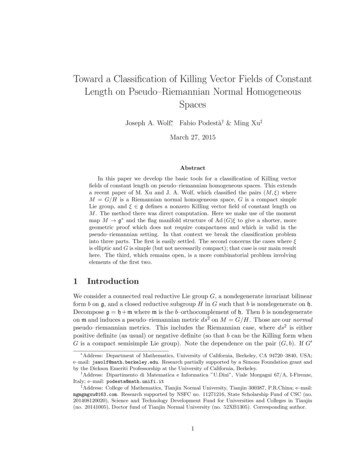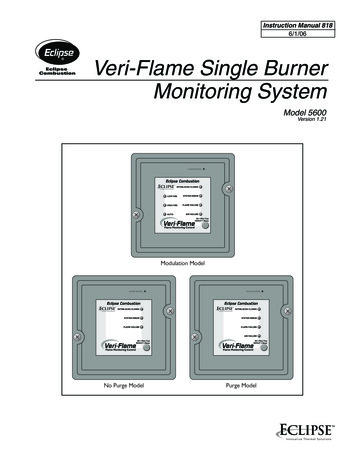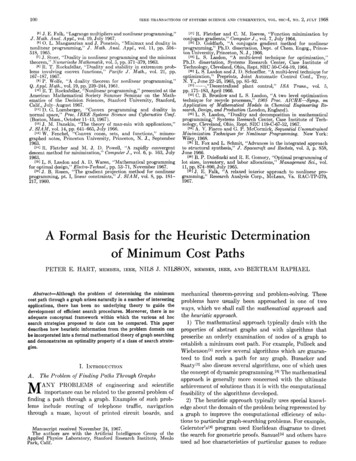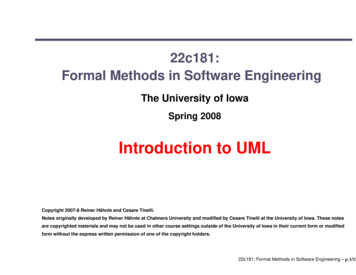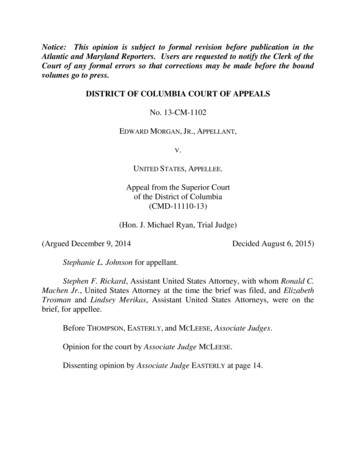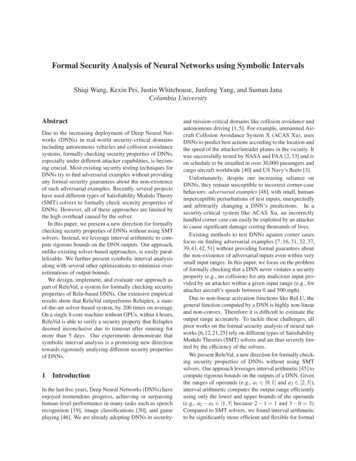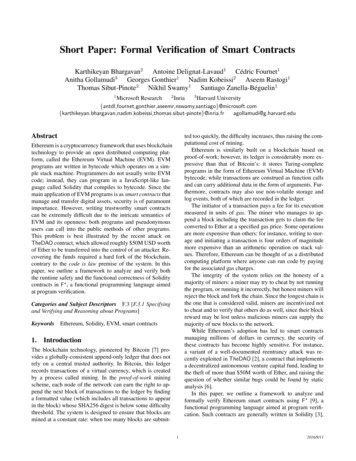
Transcription
Short Paper: Formal Verification of Smart ContractsKarthikeyan Bhargavan2 Antoine Delignat-Lavaud1 Cédric Fournet1Anitha Gollamudi3 Georges Gonthier1 Nadim Kobeissi2 Aseem Rastogi1Thomas Sibut-Pinote2 Nikhil Swamy1 Santiago Zanella-Béguelin1123Microsoft ResearchInriaHarvard .harvard.eduAbstractted too quickly, the difficulty increases, thus raising the computational cost of mining.Ethereum is similarly built on a blockchain based onproof-of-work; however, its ledger is considerably more expressive than that of Bitcoin’s: it stores Turing-completeprograms in the form of Ethereum Virtual Machine (EVM)bytecode, while transactions are construed as function callsand can carry additional data in the form of arguments. Furthermore, contracts may also use non-volatile storage andlog events, both of which are recorded in the ledger.The initiator of a transaction pays a fee for its executionmeasured in units of gas. The miner who manages to append a block including the transaction gets to claim the feeconverted to Ether at a specified gas price. Some operationsare more expensive than others: for instance, writing to storage and initiating a transaction is four orders of magnitudemore expensive than an arithmetic operation on stack values. Therefore, Ethereum can be thought of as a distributedcomputing platform where anyone can run code by payingfor the associated gas charges.The integrity of the system relies on the honesty of amajority of miners: a miner may try to cheat by not runningthe program, or running it incorrectly, but honest miners willreject the block and fork the chain. Since the longest chain isthe one that is considered valid, miners are incentivized notto cheat and to verify that others do as well, since their blockreward may be lost unless malicious miners can supply themajority of new blocks to the network.While Ethereum’s adoption has led to smart contractsmanaging millions of dollars in currency, the security ofthese contracts has become highly sensitive. For instance,a variant of a well-documented reentrancy attack was recently exploited in TheDAO [2], a contract that implementsa decentralized autonomous venture capital fund, leading tothe theft of more than 50M worth of Ether, and raising thequestion of whether similar bugs could be found by staticanalysis [6].In this paper, we outline a framework to analyze andformally verify Ethereum smart contracts using F? [9], afunctional programming language aimed at program verification. Such contracts are generally written in Solidity [3],Ethereum is a cryptocurrency framework that uses blockchaintechnology to provide an open distributed computing platform, called the Ethereum Virtual Machine (EVM). EVMprograms are written in bytecode which operates on a simple stack machine. Programmers do not usually write EVMcode; instead, they can program in a JavaScript-like language called Solidity that compiles to bytecode. Since themain application of EVM programs is as smart contracts thatmanage and transfer digital assets, security is of paramountimportance. However, writing trustworthy smart contractscan be extremely difficult due to the intricate semantics ofEVM and its openness: both programs and pseudonymoususers can call into the public methods of other programs.This problem is best illustrated by the recent attack onTheDAO contract, which allowed roughly 50M USD worthof Ether to be transferred into the control of an attacker. Recovering the funds required a hard fork of the blockchain,contrary to the code is law premise of the system. In thispaper, we outline a framework to analyze and verify boththe runtime safety and the functional correctness of Soliditycontracts in F? , a functional programming language aimedat program verification.Categories and Subject Descriptors F.3 [F.3.1 Specifyingand Verifying and Reasoning about Programs]Keywords Ethereum, Solidity, EVM, smart contracts1.IntroductionThe blockchain technology, pioneered by Bitcoin [7] provides a globally-consistent append-only ledger that does notrely on a central trusted authority. In Bitcoin, this ledgerrecords transactions of a virtual currency, which is createdby a process called mining. In the proof-of-work miningscheme, each node of the network can earn the right to append the next block of transactions to the ledger by findinga formatted value (which includes all transactions to appearin the block) whose SHA256 digest is below some difficultythreshold. The system is designed to ensure that blocks aremined at a constant rate: when too many blocks are submit12016/8/11
a JavaScript-like language, and compiled down to bytecodefor the EVM. We consider the Solidity compiler as untrustedand develop a language-based approach for verifying smartcontracts. Namely, we present two tools based on F? :hsolidityi :: (hcontracti)*hcontracti :: ‘contract ’ @identifier ‘{’ (hsti)*‘}’hsti :: htypedef i hstatedef i hmethodiSolidity? a tool to translate Solidity program to shallowembedded F? programs (Section 2).htypedef i :: ‘struct ’ @identifier ‘ {’ (htypei @identifier ‘;’)* ‘}’EVM? a decompiler for EVM bytecode that producesequivalent shallow-embedded F? programs that operateon a simpler machine without stack (Section 3).htypei :: ‘uint’ ‘address’ ‘bool’ ‘mapping (’ htypei ‘ ’ htypei ‘)’ @identifierhstatedef i :: htypei @identifierThese tools enable three different forms of verification:hmethodi :: ‘function’ (@identifier)?‘()’ (hqualifieri)* ‘{’(‘var’ (@identifier (‘ ’ hexpressioni)? ‘,’) )?(hstatementi ‘;’)* ‘}’1. Given a Solidity program, we can use Solidity? to translate it to F? and verify at the source level functional correctness specifications such as contract invariants, as wellas safety with respect to runtime errors.hqualifieri :: ‘private’ ‘public’ ‘internal’ ‘returns (’ htypei (@identifier)? ‘)’?2. Given an EVM bytecode, we can use EVM to decompileit and analyze low-level properties, such as bounds on theamount of gas consumed by calls.hstatementi :: ε htypei @identifier (‘ ’ hexpressioni)? (*decl*) ‘if(’ hexpressioni ‘)’ hstatementi(‘else’ hstatementi)? ‘{’ (hstatementi ‘;’)* ‘}’ ‘return’ (hexpressioni)? ‘throw’ hexpressioni3. Given a Solidity program and allegedly functionallyequivalent EVM bytecode, we can verify their equivalence by translating each into F? . Thus, we can check thecorrectness of the output of the Solidity compiler on acase-by-case basis using relational reasoning [1].1.1hexpressioni :: hliterali hlhs expressioni ‘(’ (hexpressioni ‘,’)* ‘)’ hexpressioni hbinopi hexpressioni hunopi hexpressioni hlhs expressioni ‘ ’ hexpressioni hlhs expressioniArchitecture of the FrameworkF*SolidityVerified TranslationSolidity*Subset of F*Source CodeEquivalenceProofEVMCompiled BytecodeVerified DecompilationEVM*Verify Functional Correctness Runtime SafetySubset of F*hlhs expressioni :: @identifierhlhs expressioni ‘[’ hlhs expressioni‘]’hlhs expressioni ‘.’ @identifierhliterali :: hfunctioni ‘{’ ( @identifier ‘:’ hexpressioni ‘,’)* ‘}’ ‘[’ (hexpressioni ‘,’)* ‘]’ @number @address @booleanVerifyhbinopi :: ‘ ’ ‘-’ ‘*’ ‘/’ ‘%’ ‘&&’ ‘ ’ ‘ ’ ‘! ’ ‘ ’ ‘ ’ ‘ ’ ‘ ’Figure 1. Overview of the architecture of our frameworkhunopi :: ‘ ’ ‘-’ ‘!’Our smart contract verification framework is a twopronged approach (Figure 1) based on F? . F? comes witha type system that includes dependent types and monadiceffects, which we apply to generate automated queries tostatically verify properties on EVM bytecode and Soliditysources.While it is clearly favorable to obtain both the Soliditysource code and EVM bytecode of a target smart contract,we design our architecture with the assumption that the verifier may only have the bytecode. At the moment of this writing, only 396 out of 112,802 contracts have their source codeavailable on http://etherscan.io. Therefore we provideseparate tools for decompiling EVM bytecode (EVM? ), andanalyzing Solidity source code (Solidity? ).Figure 2. Syntax of the translated Solidity subset2.Translating Solidity to F?In the spirit of previous work on type-based analysis ofJavaScript programs [8], we advocate an approach where theprogrammer can verify high-level goals of a contract usingF? . In this section, we present a tool to translate Solidity toF? , and a simple automated analysis of extracted F? contracts.Solidity programs consist of a number of contract declarations. Once compiled to EVM, contracts are installed using a special kind of account-creating transaction, which allocates an address to the contract. Unlike Bitcoin, where an22016/8/11
address is the hash of the public key of an account, Ethereumaddresses can refer indistinguishably to a contract or a userpublic key. Similarly, there is no distinction between transactions and method calls: when sending Ether to a contract,it will implicitly call the fallback function (the unnamedmethod of the Solidity contract). In fact, compiled contractsin the blockchain consist of a single entry point that decides depending on the incoming transaction which methodcode to invoke. The methods of a Solidity contract haveaccess to ambient global variables that contain informationabout the contract (such as the balance in this.balance),the transaction used to invoke the contract’s method (suchas the source address in msg.sender and the amount ofether sent in msg.value), or the block in which the invocation transaction is mined (such as the miner’s timestampin block.timestamp).In this exploratory work, we consider a restricted subsetof Solidity, shown in Figure 2. Notably, the fragment we consider does not include loops. The three main types of declarations within a contract are type declarations, property declarations and methods. Type declarations consist of C-likestructs and enums, and mappings (associative arrays implemented as hash tables). Although properties and methods arereminiscent of object oriented programming, it is somewhata confusing analogy: contracts are “instantiated” by the account creating transaction; this will allocate the propertiesof the contract in the global storage and call the constructor (the method with the same name as the contract). Despite the C /Java-like access modifiers, all properties of acontract are stored in the Ethereum ledger, and as such, theinternal state of all contracts is completely public. Methodsare compiled in EVM into a single function that runs whena transaction is sent to the contract’s address. This transaction handler matches the requested method signature withthe list of non-internal methods, and calls the relevant one.If no match is found, a fallback handler is called instead (inSolidity, this is the unnamed method).2.16. to translate assignments, we keep an environment of local, state, and ambient global variable names: local variable declarations and assignments are translated to letbindings; globals are replaced with library calls; stateproperties are replaced with update on the state type;7. built-in method calls (e.g.address.send()) are replaced by library calls.We show a minimalistic Solidity contract and its F? translation in Figure 3. The only type annotation added by thetranslation is a custom Eth effect on the contract’s methods,which we describe in Section 2.2. The Solidity library defines the mapping type (a reference to a map) and the associated functions update map and lookup. Furthermore,it defines the numeric types used in Solidity, which are unsigned 256-bit by default.2.2An effect for detecting vulnerable patternsThe example in Figure 3 captures two major pitfalls of Solidity programming. First, many contracts fail to realize thatsend and its variants are not guaranteed to succeed (sendreturns a bool). This is highly surprising for Solidity programmers because all other runtime errors (such as running out of gas or call stack overflows) trigger an exception.Such exceptions (including the ones triggered by throw) revert all transactions and all changes to the contract’s properties. This is not the case of send: the programmer needsto undo side effects manually when it returns false, e.g.if(!addr.send(x)) throw.The other problem illustrated in MyBank is reentrancy.Since transactions are also method calls, calling send is atransfer of program control. Consider the following malicious contract:contract Malicious {uint balance;MyBank bank MyBank(0xdeadbeef8badf00d.);function Malicious(){balance raw.value(0)(balance); // forwarding gas}Translation to F?We perform a shallow translation of Solidity to F? as follows:1. contracts are translated to F? modules;function (){ // fallback functionbank.Withdraw.value(0)(balance);}2. type declarations are translated to type declarations:enums become sums of nullary data constructors, structsbecome records, and mappings become F? maps;}It attacks the Withdraw method of MyBank by calling recursively into it at the point where it does its send. The ifcondition in the second Withdraw call is still satisfied (because the balances are updated after send, and there is nocheck that it was successful). Even though the send in thesecond call to Withdraw is guaranteed to fail (because unlike method calls, send allocates only 2300 gas for the call),it still corrupts the balance by decreasing twice, causing anunsigned integer underflow. After corrupting the balance,3. all contract properties are packaged together within astate record, where each property is a reference;4. each method gets translated to a function, no defunctionalization is required since Solidity is first-order only;5. we rewrite if statements that have a continuation depending on whether one branch ends in return or throw(moving the continuation in the other branch) or not (wethen duplicate the continuation in e
11.08.2016 · Short Paper: Formal Verification of Smart Contracts . This problem is best illustrated by the recent attack on TheDAOcontract, which allowed roughly 50M USD worth of Ether to be transferred into the control of an attacker. Re- covering the funds required a hard fork of the blockchain, contrary to the code is law premise of the system. In this paper, we outline a framework to analyze

